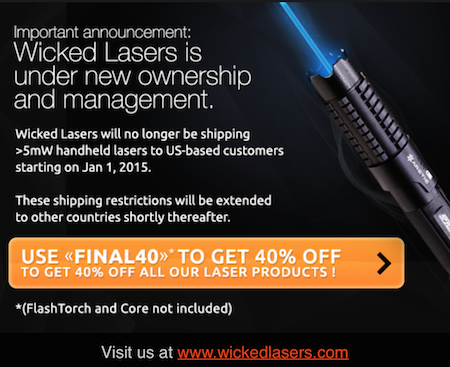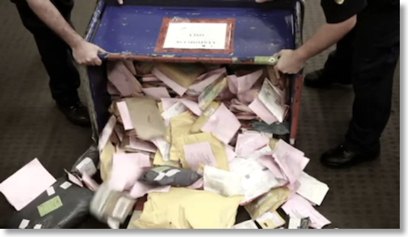Home
A comprehensive resource for safe and responsible laser use
UK: Petition to ban all laser pens looking for 10,000+ signatures
Claire Tucker undertook the effort out of fear for her husband Dan's safety. As of early September 2020, a Wiltshire air ambulance had been illuminated four times by laser light. Her husband was involved in at least one of those, on September 7, in which he saw 'red spots for a while after the laser caught him."
That night, Claire Tucker made an emotional appeal on Facebook, which was also put online by BBC News. In it she said, in part:
"Last night, Dan was in the helicopter, and all of a sudden, they were just about to come in to land. So all of a sudden, the laser light came in and caught Dan's goggles. So when it hits the goggles, it magnifies it. Number one: It could blind him. It could mean that he never gets to see his children again. If they were unlucky enough to hit the pilot's goggles, it could: A, blind the pilot, but B, disorientate the pilot, which will mean the helicopter hits the ground. Okay? So you're going to cause a helicopter crash… If you know anybody that has one of these lasers, please, take it off them, throw them out. Somebody knows somebody who's got these bloody lasers. Alright? It needs to stop. I do not want a knock on the door in the middle of the night by the police because the helicopter has come down."

Tucker during her Facebook appeal
She researched pointers online and found a laser pen on eBay with a claimed 50 mile range for £12 (USD $15.50). Her goal is to get laser pens banned for sale and importation.
Canada: Looking at "all possible options" to fight laser incidents; perhaps a ban and mandatory labels
The statement came after six laser incidents over two days earlier in the month, at Montreal’s Trudeau Airport. Garneau said these made him “very, very mad.”
A Transport official said the options include a ban on importation of powerful lasers, mandatory warning labels, and stronger penalties for those who are caught.
Garneau noted that it is hard to catch a laser perpetrator, making prosecutions “few and far between”. He believes that some people are not aware of the bright-light danger of laser light, but that others “know darn well what they’re doing” and are trying to “provoke something.”
Transport Canada currently has a program called “Not-a-Bright-Idea,” trying to educate the general public about the risks and legal consequences of aiming lasers at aircraft. Since implementing the program in May 2016, laser incident numbers have dropped. There were 590 reported incidents in 2015, 527 in 2016, and 379 in 2017.
Garneau said that despite the 28 percent drop, Transport Canada must do more, and that is why they are exploring other options.
From 660 News and AVweb
Note: In response to a LaserPointerSafety.com request, an email address for interested persons was provided: “Transport Canada is exploring options to reduce laser strikes. Canadians and industry members can provide information to the Civil Aviation Communications Centre by emailing: services@tc.gc.ca”
UK: Laser pen imports to be more restrictive
In addition, “new measures are also being introduced to tackle the sale of unsafe pointers, including more stringent testing.”
The move was supported by the British Air Line Pilots Association (BALPA).
It may help reduce the number of laser pen illuminations of trains (578 incidents were reported between April 2011 and November 2017) and eye injuries (more than 150 reported since 2013, mainly involving children).
Consumer Minister Margot James said the ministry is “going further than ever before” to police the sale of unsafe lasers.
The Argus quoted Professor John O’Hagan, of Public Health England’s laser and optical radiation dosimetry group.He said: “Over time we have become increasingly concerned about the dangers of growing numbers of unlabelled and incorrectly labelled high power laser pointers being bought by the public. It is tragic that we continue to see eye injuries, especially in children. Laser safety experts at Public Health England have worked closely with local authorities in stopping large numbers of these lasers reaching UK consumers. The extra protections proposed should help even further - if you have a laser and you don’t need it, remove the batteries and get rid of it.”
From The Telegraph and The Argus. The stories seem to be a result of the U.K. government publishing, on January 8 2018, a response to their fall 2017 Call for Evidence. The government response included the increased import enforcement actions.
See also the December 2017 news of a new U.K. law that provides stronger penalties for aiming at aircraft. The new import/consumer initiative seems to be part of the government thrust against illegal and overpowered laser pens.
Worldwide: Wicked Lasers to stop shipping high-powered lasers to U.S. on Jan. 1 2015
The sales restriction does not seem to be the result of any particular regulatory actions or other outside forces; instead it appears to be a decision by the “new ownership and management” that was also announced at the same time.
Wicked currently sells handheld lasers up to 2000 milliwatts (2 watts). In the U.S., lasers sold as “pointers” or for pointing purposes must be below 5 milliwatts output power; handheld battery-powered lasers over that power may still be sold legally if they are not “pointers” and if they meet FDA safety requirements for their laser class. All Wicked Lasers sold in 2015 will thus be within the U.S. “pointer” range of power.
The announcement came with a 40% off sale, so the company will still be shipping high-powered lasers through December 31 2014.

From the email announcement Wicked Lasers sent to customers on Nov. 19 2014 (shown above).
Spain: 10,000 pointers seized during 2013 in Balearic Islands
The four Mediterranean islands of Majorca, Minorca, Ibiza and Formentara are popular tourist destinations and are the largest of the group. They are administered as a province of Spain.
The seizures began after authorities discovered laser pointers being sold that were unsafe and/or not labeled according to regulations. Also, pilots were reporting that lasers were being aimed to try to blind the aviators.
Officers from the Directorate General of Public Health and Consumption, the Customs and Border Patrol from the Guardia Civil, and La Palma Local Police inspected the origin and labeling of laser pointers being sold in stores.
Laser pointers are only allowed in toys if they are Class 1 (less than 1 milliwatt) and there is a sign warning parents.
Class 2 laser pointers, between 1 and 5 milliwatts, are for professional use only. Lasers above 5 mW are not allowed to be sold and their use is limited.
From the EuroWeeklyNews
US: FDA asks Customs' help on illegal imports of laser pointers
Using Form 2877, the importer must submit information on each shipment and must affirm that the products comply (or do not comply) with FDA laser regulatory standards. But if a small package omits Form 2877 and is mislabeled (not using the word “laser”), this is an attempt to evade FDA and Customs. FDA specifically notes that such single-package Section 321-type imports do not meet the FDA’s criteria for enforcement discretion for personal importation.
Lasers that FDA is interested in include laser pointers, laser gun sights, laser levels, laser light shows, laser pointer key chains, veterinary laser products, laser illuminators and similar products. If a shipment does not meet FDA requirements, it can then be detained by the FDA and would not be allowed into the country.
From STR Trade Report. Thanks to New Aje Lasers for bringing this to our attention.
Sweden: Ban/restrictions proposed on laser pointers 1 mW or more
Some countries such as Australia and the U.K. have restrictions on lasers starting at 1 mW (3R, 3B and 4), while others such as the U.S. have restrictions starting at 5 mW (3B and 4 only).
The Swedish government invites comments on the proposal, EU notification text, number 2013/0365/S-X00M. This can be done up until October 4 2013 by anyone, whether a national of Sweden or not. At the EU notification link, there are additional links to obtain language-specific versions of the proposal; for example, the English draft text of the proposed laser pointer ban.
Comments can be sent to the EU Contact point Directive 98/34 at:
or send a fax to +32 229 98043. Also, Martin Lindgren of the Swedish Radiation Safety Authority has requested a copy so he is aware of the comments as well:
Additional details are below.
Click to read more...
UK: Seizure of 7,000+ laser pointers illustrates control problems
7,378 lasers were seized, along with 8,780 parts from which lasers could be assembled. It was estimated that the company sold over 35,000 laser pointers from 2009-2011, generating income of over £1,000,000 (USD $1,600,000).
Techyun Hii, 33, pleaded guilty to four charges of laser pointer violations and a fifth charge of unsafe power chargers. He was sentenced to a 180 day jail term suspended for 18 months, and to 300 hours of community service. The lasers were later incinerated in a hospital’s furnace.
Lead author John O’Hagan detailed the HPA’s findings in a paper presented at the March 2013 International Laser Safety Conference in Orlando. The case had previously been reported by LaserPointerSafety.com.
Click to read more...
US: Government agency finds most laser pointers they purchased are overpowered
The findings were made public at a March 20 2013 meeting of the International Laser Safety Conference.
Researcher Joshua Hadler designed the measurement device to be accurate, inexpensive and easy-to-use. It would cost roughly $2000 in equipment costs to make a copy of the NIST device; plans are available from NIST for interested parties.
From a NIST press release, March 20 2013.
Click here for the full press release:Click to read more...
Australia: Ban on laser pointers has been a "detriment" to safety
The author, Trevor Wheatley, is chair of the Standards Australia SF-019 Committee on laser safety. He studied 41 lasers purchased online in 2012 that were claimed by the sellers to be legal -- lower than the Australian import limit of 1 milliwatt. Most cost less than AUS $20.
Wheatley found that 95% of these pointers were illegal under Australian law, with outputs above 1 mW. Of the 41, 78% were between 5 mW and 100 mW. (5 mW is generally taken to be the highest safe power for a general purpose laser pointer.)
Based on Wheatley's research, "...there would appear to be a greater than 50% chance that someone attempting to buy a 'safe' laser pointer would inadvertently get a hazardous laser." Further, 100% of the tested laser pointers below $20 "would represent prohibited weapons in most Australian states."
From other statistics, the paper states that "availability has not been significantly impacted." In 2007/2008 there were 648 incidents involving lasers pointed at aircraft. In 2010/2011, well after the import and possession restrictions, the number of incidents had increased to 828.
Click to read more...
Australia: Illegal laser imports up 60%; threaten aircraft safety
Illegal imports of laser pointers explode - 24 July 2012
Customs and Border Protection is warning travellers and online shoppers about Australia’s tough laws prohibiting the import of laser pointers.
This follows a dramatic increase in the number of these dangerous items being seized by officers at the border.
In the past year, the number of laser pointers seized by Customs and Border Protection officers at the Sydney International Mail Centre alone has increased by close to 60 per cent, from around 9,000 to over 14,000.

Australian import officers spill out a container full of confiscated packages of illegally-imported laser pointers.
Importing laser pointers greater than one milliwatt in intensity is prohibited in Australia without a permit.
“The sheer volume of these importations suggests that people do not understand the threat these items pose to safety, particularly to commercial aircraft,” said National Manager Cargo Operations, Jagtej Singh.
Customs and Border Protection officers are trained to detect prohibited and restricted items from the millions of items which arrive each week.
“If you try and import laser pointers without a permit, there’s a high possibility they’ll be found by Customs and Border Protection, seized, and you may even face fines of up to $275,000.”
Customs and Border Protection has produced a video clip outlining the risks being taken by people who inadvertently or deliberately breach the laws on laser pointers.
It can be viewed on the agency’s YouTube channel.
According to this video, “Customs officers screen all incoming mail imported into Australia, and items such as laser pointers WILL show up on X-ray.”
Media enquiries: Customs and Border Protection Media (02) 6275 6793
From Australia Customs and Border Protection
Germany: 273 (or 388) incidents in 2010; call for ban on pointers
He recommended fast action. He discussed a European import ban, as well as classifying lasers as a weapon, and prohibiting private possession of Class 3 and Class 4 lasers. He said, “I call on the competent authorities to submit to the problem of dangerous laser fast red tape as possible solutions, before something happens and people get hurt.”
The pilot’s union Vereinigung Cockpit said an import ban is not sufficient, because customs checks are difficult. Cockpit board member Joerg Handwerg said "Although lasers may not be sold in shops with a capacity of more than one milliwatt in Germany, but you get the devices in the Internet.” The group wants to prohibit the possession of equipment for private individuals.
Original articles (in German) from Rettung Magazine, Fluege.de News, and Heute.de.
*NOTE: An April 23 2011 article from N-TV.de says there were 388 “attacks with laser pointers at pilots” in 2010. This is according to the German air traffic control agency, DFS. The article had no additional information that might account for the discrepancy with the 273 incidents in 2010 that is quoted above.
US: NY Times says injury increase feared from higher powered lasers
The article listed four injuries to youths. In three of the incidents, a young person deliberately stared into a laser beam, while the fourth was caused by a high-schooler whose friend waved a 50 mW laser in his face. (Besides these anecdotal accounts, the article gave no overall statistics on injuries except to say that an ophthalmologist association is “unaware of any increase in eye injuries caused by lasers.”)
Author Christine Negroni covered a number of topics, including:
- There has been “ninefold increase over five years” in laser illuminations of aircraft
- Eye doctors are “shocked” that high-powered lasers are available on the Internet with no purchase restrictions.
- A U.K. physician says the U.S. limit should be 1 mW, that even at 5 mW laser pointers have “acute” dangers.
- FDA says that noncompliant (“illegal”) lasers are available despite agency seizures.
- Wicked Lasers says that its products are compliant, that they are “extremely clear” about eye and fire hazards on their webpages, and that they will be offering online safety lessons “before checkout”.
- A “large community” of laser enthusiasts wants to keep lasers available.
- An 18-year-old laser hobbyist, who wears goggles and is supervised by his parents, said he was learning about electronics, soldering, physics, light, optics and mechanics.
From the New York Times, online on Feb. 28 2011, in print on March 1 2011 on page D5 of the National edition.